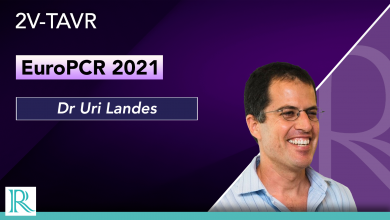Search results
Author(s):
Kathryn Dawson
,
Tara L Jones
,
Kathleen E Kearney
,
et al
Added:
3 years ago
Advances in transcatheter structural heart interventions and temporary mechanical circulatory support (MCS) have led to increased demand for alternative sites for large-bore vascular access.1 Percutaneous axillary artery (AA) access is an appealing alternative to standard femoral access when the patient has iliofemoral peripheral arterial disease (PAD), obesity or there is an expected device…
View more
Author(s):
Pavel Overtchouk
,
Thomas Modine
Added:
3 years ago
This article aims to provide an updated comparative review, addressing the respective strengths and weaknesses of different alternative transcatheter aortic valve implantation (TAVI) approaches.
The transfemoral (TF) access is favoured by international guidelines on TAVI because of its reported superiority to the transthoracic approach.1–3 In spite of the progress in miniaturisation of new…
View more
Author(s):
Luai Tabaza
,
Sanjog Kalra
,
Jon George
,
et al
Added:
4 years ago
Jaikirshan Khatri
Research Area(s) / Expertise:
Job title: Director of Complex Coronary Interventions
Author
Author(s):
Uri Landes
Added:
2 years ago
Dr Uri Landes (Rabin Medical Center, Petah Tikva, IL) discusses the results from the 2V-TAVR study. This retrospective cohort study used data from an international registry of 21 298 to assess incidence, causes and outcomes associated with urgent implantation of a supplementary valve during transcatheter aortic valve replacement.
Questions
1. What was the rationale behind this study?
2. What was…
View more
Trans-catheter Aortic Valve Implantation Guidelines - Does the Latest Evidence Change our Views?
Author(s):
Hannah McConkey
,
Bernard Prendergast
Added:
3 years ago
Article
Author(s):
Zaccharie Tyler
,
Oliver P Guttmann
,
Konstantinos Savvatis
,
et al
Added:
2 years ago
Author(s):
Benjamin H Holland
,
Robert J Applegate
Added:
3 years ago
Abstract
Femoral access remains a vital route for many cardiac and non-cardiac procedures, including those involving the use of large delivery systems. In the common femoral artery access is extremely important to minimise complications and optimise use of closure devices. Dissatisfaction with haemostasis achieved by manual compression stimulated development of VCDs that provide quick and…
View more
Overcoming the Challenges of the Transfemoral Approach in Transcatheter Aortic Valve Implantation
Author(s):
Stephane Noble
,
Marco Roffi
Added:
3 years ago
Article
Author(s):
Andrea Pacchioni
,
Dimitris Nikas
,
Carlo Penzo
,
et al
Added:
3 years ago
Transcatheter aortic valve implantation (TAVI) and endovascular aortic repair (EVAR) are increasingly being used as therapeutic options for patients with severe aortic stenosis ineligible for surgery and with aortic aneurysm with suitable anatomical features. Despite encouraging results from randomised studies and registries regarding the pursuit of endovascular treatment in selected patients,…
View more















